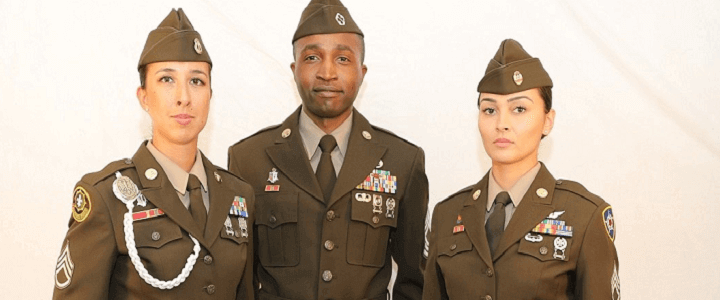As the country was observing Veterans Day on Monday, U.S. Army quietly made its long-awaited uniform announcement. For more than a year, the Army leadership has been teasing (or tormenting, depending on your point of view) soldiers with photos of a new “Army Greens” uniform modeled on the World War II uniform known as “pinks and greens.” With Monday’s stealth news release, it’s now official.
The traditional blue uniform, only recently adopted for everyday wear but reminiscent of the Army’s traditional uniform color, will change to a dark, brownish-green jacket with trousers and skirts of a taupe shade that is technically a shade of khaki, but is almost pink, giving rise to the uniform’s name. It’s the uniform Lyle Waggoner wore as Maj. Steve Trevor alongside Lynda Carter in the 1970s television adaptation of Wonder Woman.
There will be a long lead time for this change. The first soldiers to get their new uniforms will be new recruits in 2020. The uniform won’t become mandatory for everyone until 2028. Someone who enlisted in 2008 will be eligible to retire by then. The Army promises that those enlisted soldiers who remain will be able to afford the new uniforms with their annual clothing allowances. And they won’t cost any more than the current uniforms, meaning the taxpayers won’t be footing a bigger bill to outfit the Army.
Too many changes?
Soldiers are generally cynical, and are also generally not shy about sharing that cynicism. There’s been no shortage of opinions regarding this move. The most frequent criticism is that recently, the Army has expended entirely too much energy on uniform choices, and made too many changes too quickly, only to reverse them later. Beginning with Gen. Eric Shinseki’s 2001 decision to issue black berets to all soldiers. From 1974 through Shinseki’s announcement, the black beret belonged to the Ranger Regiment.
The black beret as military headgear originated with British tankers in World War II and is still worn by armored forces in virtually every other Army in the world. My instructors in the Scout Platoon Leader’s Course at Fort Knox in 1990 covertly donned completely unauthorized black berets with red and white cavalry flashes as soon as we were out of sight of the main post. But in the U.S., the black beret meant “Ranger,” and even though the Rangers adopted the tan beret worn by their British Special Air Services comrades, there are still rumblings of resentment.
Then the woodland camouflage patterned Battle Dress Uniform, and its tan equivalent the Desert Camouflage Uniform, gave way to the Army Combat Uniform in “Universal Camouflage Pattern.” Despite the more comfortable fit (some said it was like wearing pajamas to work), and the suede boots that didn’t need to be shined, the uniforms faced justified criticism. The trousers wore out quickly in the field, and the camo pattern was universally bad. So we replaced the cam pattern again, and modified the uniform further.
The Dress Greens, which had replaced the original “pinks and greens” in 1954, were the next to go. Dress Blues had been a more formal uniform for much longer, but became the “Army Service Uniform,” for everyday wear. While many criticized the ASUs as looking like a bus driver’s uniform, this was largely the result of choosing a white shirt rather than khaki one. But the dissatisfaction lingered.
Sergeant Major of the Army Dan Dailey heard the complaints. He did some market research and found that pinks and greens were a popular choice. So here we are.
Uniforms are important
To civilians, this may seem silly, grown men (and women) arguing over what color to wear and how the beads and baubles should be arranged. But uniforms are important. They identify you as a member of a group, whether that group is the military, police and fire departments, the Postal Service, park rangers, or the Boy Scouts. They show you belong to something larger than yourself. They make you one with the others who wear the same uniform.
They also give the wearer a chance to boast. To civilians, the “fruit salad” of ribbons may look like a jumble of color. But there’s a story (though not always an interesting one) of achievement behind each ribbon and badge… even if that achievement is simply wearing the uniform at the right time in history. The military, it is often said, wears its resume on its chest.
Awards are motivators. Napoleon Bonaparte supposedly said, “A soldier will fight long and hard for a bit of colored ribbon.” This is undoubtedly true. We ask our young men and women in uniform to do unbelievable things. We ask them for as much devotion as a human can show. Having a uniform that gives them pride is important.
There’s a lot of quiet but persistent uncertainty in the military about the future of the war in Afghanistan, about how much more sacrifice the military, let alone the nation, can bear with so little outward progress to show for it. Many soldiers don’t feel like they’re winning anything. But the uniform our grandfathers and great-grandfathers wore as they beat back the Nazi menace in Europe? There’s a uniform that represents winning decisively.
If trying to recapture some of that magic of what historian Studs Terkel called “The Good War” helps the modern Army feel like the Army it deserves to be, then the uniform change will be worth it. Even if some still aren’t happy.




